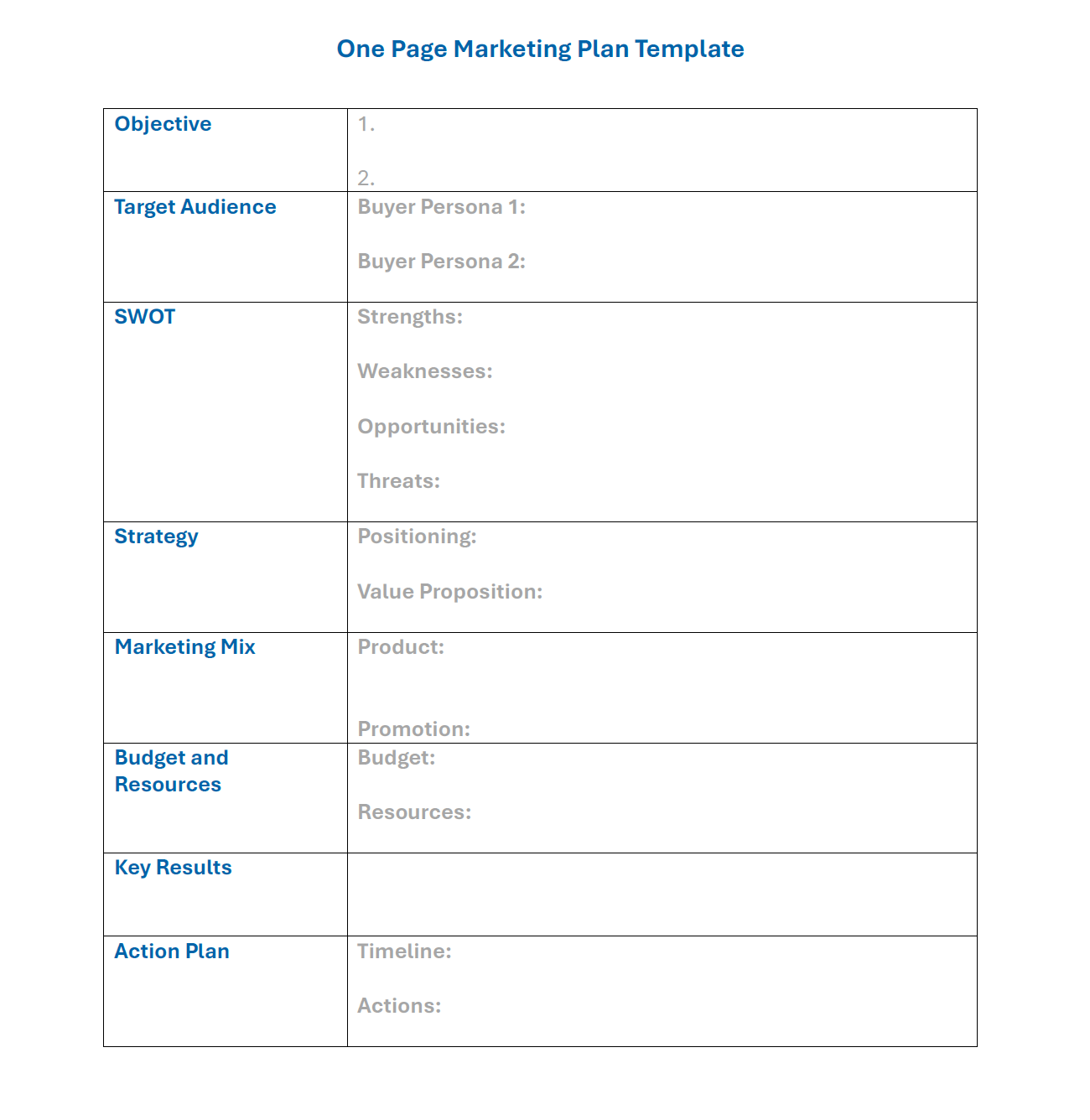One Page Marketing Plan
A one page marketing plan is a concise and comprehensive document that encapsulates the essential elements of a full marketing strategy on a single sheet of paper. It’s only a one page marketing plan, so use this to get the specifics summarized for yourself, your team, or your leadership. All your other details can go into a more robust marketing plan. This streamlined format helps businesses quickly understand and communicate their marketing goals, target audience, strategies, and key metrics. By focusing on the most critical aspects, a one page marketing plan ensures clarity and alignment across the team, enabling more effective execution and monitoring of marketing activities. This approach is particularly useful for small to medium-sized businesses that need a clear and actionable marketing roadmap without the complexity of a lengthy document.

Here’s How to Use the One Page Marketing Plan Template
Objective
The objective section outlines the specific, measurable goals that the marketing plan aims to achieve. Remember to align any goals you have here with the overall business objectives and provide a clear direction for all marketing activities. Examples include increasing brand awareness, generating leads, or driving sales growth.
Target Audience
The target audience section defines the key customer segments that the marketing plan will focus on. This includes detailed buyer personas, otherwise known as Ideal Customer Profile (ICP), that describe the demographics, psychographics, needs, and pain points of your ideal customers. Understanding your target audience helps tailor marketing messages and strategies to effectively reach and engage them.
SWOT
The SWOT analysis identifies the internal and external factors that can impact the success of the marketing plan. This includes evaluating your company’s Strengths, Weaknesses, Opportunities, and Threats. Conducting a SWOT analysis helps recognize areas for improvement, leverage strengths, and mitigate potential risks.
Strategy
The strategy section describes how the company plans to achieve its marketing objectives. It includes a positioning statement and value propositions that highlight the unique benefits and differentiators of the company’s products or services. A well-defined strategy ensures that all marketing efforts are cohesive and aligned with the company’s goals. Learn more about our positioning workshop here.
Marketing Mix
The marketing mix outlines the key elements of the company’s marketing strategy. Use this section to detail the products or services offered, pricing strategy, distribution channels, and promotional tactics. The marketing mix provides a comprehensive approach to reaching and satisfying customers.
Budget and Resources
This section details the financial and human resources allocated to the marketing plan. It includes a high-level budget that specifies how funds will be distributed across different marketing activities and the key resources required to execute the plan. Effective budgeting and resource allocation ensure that the marketing plan is feasible and sustainable.
Key Results
The key results section lists the specific metrics, results, and KPIs that will be used to measure the success of the marketing plan. These results should be directly tied to the marketing objectives and provide a clear way to track progress and impact. Common KPIs include website traffic, conversion rates, and lead generation. See the blog post on marketing metrics.
Action Plan
The action plan outlines the activities and timelines for implementing the marketing strategy. It includes detailed tasks, responsibilities, and deadlines to ensure that all aspects of the plan are executed efficiently. To keep this as a one page marketing plan, use short statements for this section. Be as specific as possible. The action plan serves as a roadmap to guide the marketing team through each phase of the campaign, ensuring alignment and accountability.